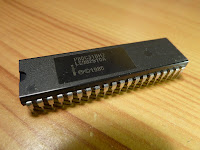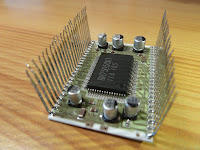Links
Watching these ancient integrated circuits you can realize how fastly the world is changing. Most of them come from 1970s or 1980s. It's not too long period of time, just 30 years! But they are completely different than ICs used nowadays.
Microcontrollers
A microcontroller is a processor conected with memories, ports, timers and other peripherals in a single package. Integrated circuits with characteristic circular window have EPROM momory. To erase the memory you need to expose the chip to the UV radiation. These chips are very rare to the collectors due to their visual values :)

8031
Simplified version of 8051 microcontroller.

8035
ROM-less version of 8048. It has 64 bytes of RAM.

8049
It's a high-end version of 8048 that has twice more RAM memory than the original one. Exactly: 128 bytes. It has 2kB one time programmable ROM.

8051
A microcontroller that revolutionized the world! It has spread electronic equipment into everyday usage equipment. The size of ROM is only 4kB, but there's a possibility to connect an EPROM up to 64kB. It has 128 bytes of RAM, but also you may add external RAM up to 64kB.

8741
Same as 8041 but with UV-erasable 1kB of EPROM. RAM size is 64B.



8742
Similar to 8741 but with twice bigger RAM and ROM: 128B and 2kB. I love this photo!



8748
Another development version of Intel microcontrollers. 1kB EPROM, 64B RAM. It has RC generator inside, so there's no need of connecting external clock source. Two timers and 27 universal I/O pins.



8749
Same as 8748 but with twice larger memory.




8751
Identical to 8051 but with EPROM memory.



Hitachi HD63701
A microcontroller compatible with Motorola 68000. It was used in game consoles. Here's a list of games written for this CPU:
http://www.mamedb.com/cpu/HD63701.




80C45ICCN64
The GIANT version of 8051 made by Signetics. It's in DIL64 package and it's about 8cm wide!


87C51HB
Similar to the above one, but in a bit smaller package.


Piggyback 85CI54
Extraordinary rarity!!!!! This is the 8051 designed especially for prototyping. Why? Microcontrollers with EPROM memory had a disadventage - when you wanted to program the momory, you had to unplug them from the circuit board, put into UV-eraser, put into the programmer and finally plug it into the prototype. It was very inconvenient and time consuming. Moreover, EPROM memory was very perishable. It lasted for about 50-100 cycles of programming and then the processor became a rubbish.
PIGGYBACK processor doesn't have internal ROM at all. That's why there's a socket on their back to connect external ROM or ROM simulator. This way engineers could easily and fast test now software without ther risk of damaging memory. This kind of ICs were used only in design offices and they were horrendously expensive.






ST92E141K4D0
Processor used in AC motor inverters. Especially designed to 3-phase motor controllers. You can easily find the datasheet on the web. It's one of the most beautiful integrated circuits in my collection. I don't know why the chip shines like a rainbow. It's interesting that there's 32 pins in the package but on the chip there's over 60! Seems that there were some different versions of this IC and they differed with amount of IO pins, but each of them consisted of the same chip.






PIC12CE519
Tiny microcontroller with EPROM memory. It's interesting that there are two chips inside the package. The bigger one is connected with bonding wires to the pins of the package. It is the processor. The smaller chip is memory and it's connected with bigger one with four thin wires. It's memory with serial interface.




Mikroprocesory
CEMI MCY7880
The only Polish microprocessor, the 8080 clone. I've found a Russian chip inside this.

Zilog Z80
A microprocessor known from ZX Sprectrum. There was a time when it dominated even Intel, but this time has gone and will never come back.

EPROM memories
MCY7716
The only Polish EPROM. Many people claimed it never existed. Indeed, it's very very rare. Produced in early 1989 and in the March of 1990 in CEMI. Most of there integrated circuits were recycled to reuse gold. Viewing under the micoscope I see the "U2716" label. Probable the chip was manufactured in German Democratic Republic and it was only packed in Poland.







EPROMy SMD
27C256 and 27C512 in SMD packages.



К573РФ5
Bolshaya tekhnika, integrated circuits from Soviet Union. Their pitch was 2,5mm not 2,54mm as in circuits from rest of the world. The package is also unusual, such as its name that means nothing to me. Under the microscope you can found a label written with Cyrillic alphabet.





К573РФ2
Another Soviet EPROM with unusual package.


MM2758Q
Strange EPROM with golden pins.


EPROM memories
I have a collection of EPROMs taken from some old equipment. I like them very much because I can clearly see what's there inside them.



Other integrated circuits
Mostek MK6010
This is the first calulator integrated into a single chip! It was used in Busicom junior/NCR 18-16. It replaced over a dozen ICs used in previous versions of this calculator. Inside MK6010 there are 360 logic gates, 160 flip-flops made up with 2100 transistors. Year 1972 and 1973.
More info:
Vintage Calculators




MRY7906
This is the clone of ICL7106 made by Polish factory CEMI. Very rare. I can't find it's datasheet nowhere and perhaps it never existed. This chip is working and compatible with all meters designed to work with ICL7106.


74181
Arithmetic logic unit. Nowadays every processor contains this unit.

Others from CEMI
CEMI produced integrated circuits for microcomputers - MCY7114 (2 szt), UCY74S416, UCY74S405, UCY74S424, UCY74S487, UCY74181 (ALU), MCY7880, UCY74S412, MCY7304AA, UCY74S428, MCY7102C, UCY74S482, UCY74S486.


40116
TTL-CMOS level translator. Made of very good looking violet ceramics and golden pins. I have two identical chips so I opened one of them. The chip topology is so simple that I can see single transistors.




MN6740VCQK
I have no idea what is it. Comes from old Panasonic video player.


Ceramic hybrid
A strange monster :)



Links








































































































































